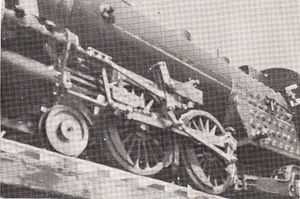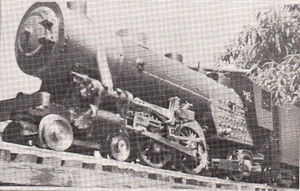C.J. Hull
The North American Live Steamer, Volume 1 Number 4
Here are three of the pictures that I promised to have made for you.
Photo 1 is a fair view of the fabricated drive wheels 6-1/4 inch on the tread. They look quite a bit like cast ones.
Photos 1 and 2 give a good view of the fabricated cylinder block. The data on this is:
- 1-1/2 inch bore
- 2-1/2 inch stroke
- Piston valves (no rings as yet) 7/8 inch dia by 3/4 inch travel, long lap,
- 75% cutoff
The cross head in Photo 1 is a Martin Lewis casting, modified to the laird type---back cylinder head is also Martin Lewis material treated likewise. No alteration on the valve guide head. The side and main rods are 1040 HRS torch cut to shape and hand ground to produce the profile. Motion work all cut from solid material and electric welded where necessary. All of the truck wheels were torch cut from 3/4 inch 1040 HRS plate.
Photo 3 not so good. It's supposed to show the fabricated trucks, but it's a little dark under there. Nevertheless, they are fully sprung with swing motion centering, as is the front engine truck, which uses heart link centering. Tender tank is 12 gauge steel, all welded construction--frame is 1x1x1/8 inch angle also welded.
- C.J. Hull
- Dominguez Short Line
- Long Beach, California
Where to Get It
The North American Live Steamer, Volume 1, Number 9
One thing I have noticed that exceeds others is, "Where can I get this or that, for this part, it has to be this size?". I, too, am a practical minded man. I, to, want something for a job now and then, but the cost of some materials needed is beyond my purse, so I start looking for a reasonably good substitute that will do the job and can be trusted to give reasonable service.
We have several classes of live steamers with one thing in mind - build and enjoy our live steam projects, be what it may. This note deals with all of you who, at some time or other, hesitates at cutting a couple of inches off an expensive piece of stock for a part that has to give good service and be tough about it.
There are innumerable keys, pins, levers as in valve gear and other motion parts. Long stud bolts that must be tougher and harder than mild steel. So to some of us, drill rod and tool steels are out of the question. (I've been out on strike since December 1956). So lets take a couple of our hard earned bucks and pay a visit to our local welding supply house. He has, or can get, a wide variety of arc welding electrodes used in hard facing work. These are coated rods and are annealed and can be filed, drilled and machined with ease. The coating on most of them is very thin and easy to remove. They are manufactured in several sizes ranging from 3/32 inch through 3/16 inch and up to 14 inches in length. Don't try to use the "wire" types, as they are not all of uniform diameter and are extremely hard. Lets ask for some "100 hardweld". It is made by the Lincoln Electric Co., with a light tan coating easy to remove. Three sizes: 3/32 inch, 5/32 inch and 3/16 inch. It will air harden or can be made into a real tough part by heating to cherry red and dunking in cold water or oil. If your supplier doesn't handle Lincoln electrodes, get them made by G.E., Westinghouse, P & H or N.C.G. (National Cylinder & Gas). These are all equal in quality, but heavier coating. Also, we can buy 50 pounds of this material for the price of 10 pounds of drill rod or tool steels.
Now for some other items needed: 1/4 inch diameter brazing rod (brass or bronze) for hand rail supports, etc., 3/32 inch or 1/8 inch stainless steel, heliarc welding wire for the hand rails. Both of these come in 36 inch lengths, plenty left over to play with.
OK! Now you have the idea and I'm sure your local dealer will et you look around and "feel" the stock, so to speak, and see what you are buying.
For the fellows who don't have to watch their budgets too close, they can really get in some practice and not waste expensive material on trial pins, bolts, etc.
Also, for all of us, the welding supply house can supply all sizes of mild steel electrodes from 1/16 inch through 3/8 inch brazing wires, both brass and bronze 1/16 inch through 3/8 inch - some brands of brass wires contain quite a bit of aluminum which makes them hard to drill or turn.
In closing, lets not sell short the lowly wire coat hanger. Its just the size you need for those long No. 3 studs.
Enclosed is a picture of the finished job here, which uses some of all the materials mentioned in the foregoing note. "100 hardweld", for motion pins and keys, 3/32 inch stainless for hand rails, 1/4 inch brass brazing rod for hand rail supports.
If you don't have a welding supply house near you try the nearest hardware, garage or blacksmith or welding shop. Who can tell what you will find. Remember, "When in doubt, ask!"
Good steaming for 1957.
- C.J. Hull
- Dominguez Short Line
- Long Beach, California



